"There are two kinds of light - the glow that illumines, and the glare that obscures."
- James Thurber
Glare and the Bioptic Driver
Problems with light and glare can endanger any driver. Uncontrolled glare may mask oncoming traffic and limit the ability to see signs and brake lights. Glare control is one of the most critical issues that must be dealt with for safe bioptic driving. Not controlling glare can lead to failure of an otherwise good bioptic driving candidate or make the driver less safe on the road.
Low vision patients vary on their light sensitivity. Some conditions require much more stringent control of light and glare. Safe bioptic driving requires a combination of careful control of glare and anticipation of potential glare problems.
The low vision specialist will determine the degree of glare problems and appropriate treatments including sun filters, hats, visors and other adaptive steps. The low vision specialist may advise some patients to avoid driving just after sunrise and just before sunset, where low-lying sun might cause significant glare problems.
Glare Problems in Bioptic Driving
Photostress or Poor Glare Recover: When the energy of light bleaches out the chemicals in the retina, a temporary decrease in vision may occur. We all experience a brief form of this when we have a flash picture taken and notice a temporary spot in our vision. Patients with central retinal disorders like macular degeneration and Histoplasmosis may bleach-out severely and not quickly recover to their base vision
Discomfort Glare or Photophobia: Discomfort glare is the visual discomfort or pain caused by very bright light such as direct sunlight or bright lamps. It can vary from mild annoyance to overwhelming pain.
Disability glare: Disability glare is the situation where vision is impaired by excessive dazzle from a bright light source or reflection such as light reflecting from a glossy surface or from water. The degree of this impairment can vary from minor low contrast veiling glare across the vision to severe temporarily blinding glare.
Use of Selective Sun Filters in Bioptic Driving
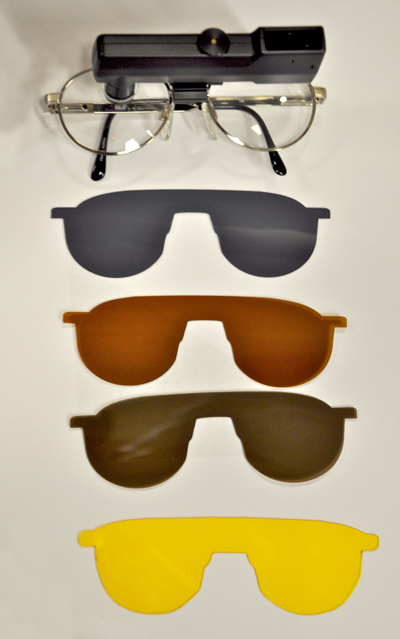 Proper sunglasses are helpful for most drivers, but critical for low vision patients who are often more easily impaired by glare. The low vision specialist can determine the proper type of filter. The color and properties of the filter are important. Many patients with retinal disorders do better with amber/blue blocker colors that reduce blue light. Sunglasses must be adapted to the type of bioptic utilized.
Proper sunglasses are helpful for most drivers, but critical for low vision patients who are often more easily impaired by glare. The low vision specialist can determine the proper type of filter. The color and properties of the filter are important. Many patients with retinal disorders do better with amber/blue blocker colors that reduce blue light. Sunglasses must be adapted to the type of bioptic utilized.
Bioptic Driving Sun filters
In fitting the Ocutech Sport we prescribe four filters for the patient to slip-in behind the carrier eyewear. These include a yellow filter, which helps some patients on overcast, foggy or rainy days and blue light reduction filter, brown and gray filters for the patient to experiment on their needs in different situations. Two dark filters can be riveted together to create a much darker filter if needed.
Additionally in patients more affected by glare, a small slip-on sun filter can be snapped over the front objective of the bioptic to control glare through the telescope. This also can be quite helpful for the bioptic driver with a required driving path towards the low-lying sun such an evening drive home from work.
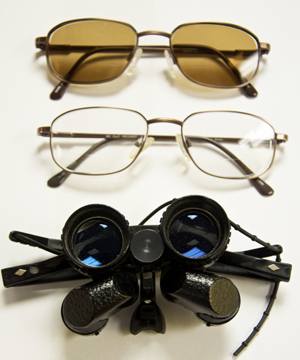 In fitting the Beecher Mirage we use two separate sets of regular eyewear with little or no tint and sun wear. One is for low light level such as overcast days and evening. The other is a sun filter for bright light.. We avoid a slip in sunglass as it adds a needless third movable element to the system. Filter caps for the objective lenses can be prescribed if needed.
In fitting the Beecher Mirage we use two separate sets of regular eyewear with little or no tint and sun wear. One is for low light level such as overcast days and evening. The other is a sun filter for bright light.. We avoid a slip in sunglass as it adds a needless third movable element to the system. Filter caps for the objective lenses can be prescribed if needed.
Glare from Light - Vehicle Interaction
Glare from the dashboard: Sunlight reflecting off a dashboard may create a veiling glare that disrupts the patient’s vision. During training driving rehabilitation specialists may place a dark matte across the dashboard to further reduced reflective glare. Proper selection of an automobile for a bioptic driver should include looking at 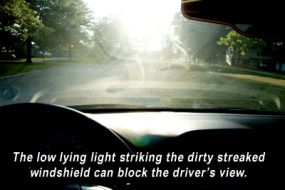 the potential of glare from the hood and dashboard. Fortunately, today most dashboards have matte finishes.
the potential of glare from the hood and dashboard. Fortunately, today most dashboards have matte finishes.
Windshield Glare: As glare strikes the windshield, dirt and streaks may scatter light causing a dangerous dense disability glare. Regularly cleaning the windshield and replacing worn wiper blades may reduce these issues.
The Glare of Low Lying Sun and Bioptic Driving
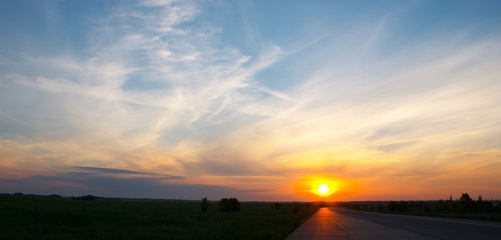 Low Sun Glare: Driving into low-lying sunlight may create a dense disability glare that can temporarily blind the driver. Sunglasses and use of the visor may be helpful. Patients with corneal and cataract opacities are particularly susceptible to this glare. In some low vision patients such as those with macular degeneration or Histoplasmosis, the severe disability glare may be further amplified by poor glare recovery. Turning from a north south path towards low-lying sun may suddenly create a debilitating glare. Anticipating the roadway and sun postion and thus the potential problem in turning into the sun can help bioptic drivers. Likewise the effect of turning from a very bright path onto a dimmer tree lined street must be anticipated. Some patients will be advised to avoid driving into low lying sun in the morning or evening.
Low Sun Glare: Driving into low-lying sunlight may create a dense disability glare that can temporarily blind the driver. Sunglasses and use of the visor may be helpful. Patients with corneal and cataract opacities are particularly susceptible to this glare. In some low vision patients such as those with macular degeneration or Histoplasmosis, the severe disability glare may be further amplified by poor glare recovery. Turning from a north south path towards low-lying sun may suddenly create a debilitating glare. Anticipating the roadway and sun postion and thus the potential problem in turning into the sun can help bioptic drivers. Likewise the effect of turning from a very bright path onto a dimmer tree lined street must be anticipated. Some patients will be advised to avoid driving into low lying sun in the morning or evening.
Night Driving Issues and Bioptic Driving
Headlight Glare: Headlight glare at night causes a brief dazzling glare, but in some patients with poor glare recovery 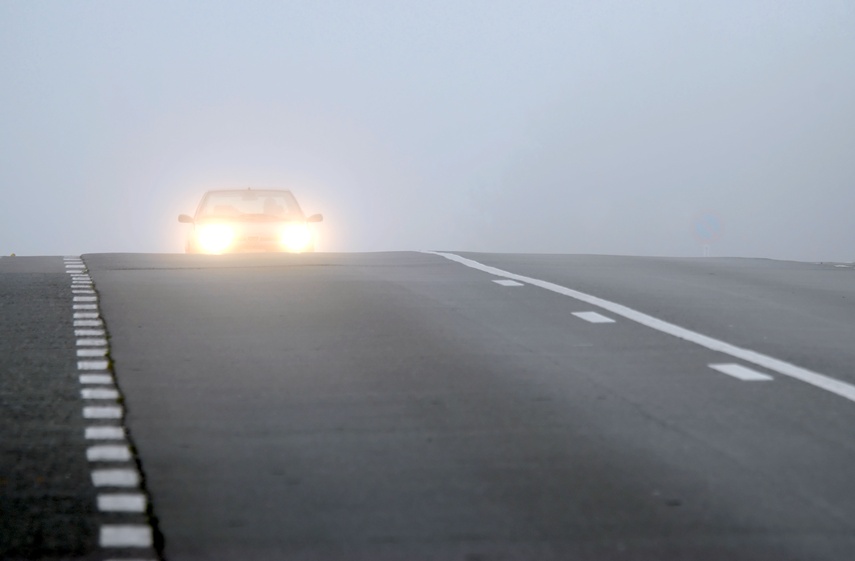 repeated exposure to the bright headlights may cause temporary reduced vision. Sunglasses should not be worn at night. Proper techniques of looking at the side of the road to avoid the oncoming light should be used. Some patients feel yellow filters aid them at night, but any filter can reduce light available to the driver. The use of filters at night should be reviewed with your doctor.
repeated exposure to the bright headlights may cause temporary reduced vision. Sunglasses should not be worn at night. Proper techniques of looking at the side of the road to avoid the oncoming light should be used. Some patients feel yellow filters aid them at night, but any filter can reduce light available to the driver. The use of filters at night should be reviewed with your doctor.
Bioptic drivers requesting night driving privileges in Indiana must have an initial recommendation by the doctor followed by a night driving evaluated by the driving rehabilitation special. These recommendations are forwarded to the Indiana BMV, which makes the final determination. It can be obtained during the initial licensing, but in some cases it is deferred until the driver has more experience with bioptics. Night licensure varies by state.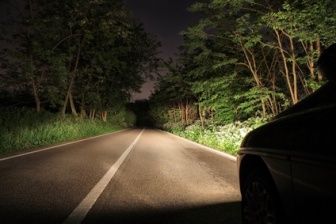
Some bioptic drivers with mild visual field impairments that are adequate to pass for daytime driving may not be as safe for night driving. This group might include bioptic drivers after laser treatment for diabetic retinopathy and some macular degeneration patients. Each case must be looked at individually.
Some bioptic drivers actually function better at night. The most common examples are patients with Achromatopsia or other Cone Dystrophies.These patients lack adequate cone cells for bright light vision, but do have adequate rod cells for night vision. In bright light, they use special filtered contact lenses and sunglasses, but remove them for night vision.
Poor Contrast Sensitivity
Bioptic Driving in Rain or Fog
Decreased Contrast in Rain and Fog: A related problem is the reduced contrast sensitivity in rain and fog. Yellow filters often help contrast perception in these conditions. Bioptic drivers learn early the safe range of their visual environment. Most avoid bad weather situations.
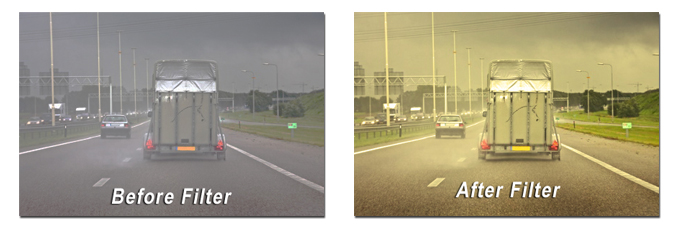
Traffic Lights and Bright Background Light: A traffic light can be difficult to view from a distance when overwhelmed by a bright sky. The human eye attempts to adapt to see the traffic light, but is overwhelmed by the brighter background light. Sun filters are helpful.
The Special Case of Achromatopsia / Cone Dystrophies
For more info please visit our sister website Achromatopsia.info
Some patients will experience much more debilitating glare due to their condition. In Achromatopsia and cone dystrophies, patients suffer debilitating glare. It occurs due to the lack or impairment in functioning of the cone cells. New technology in the form of the Optical Coherence Tomography (OCT) allows us to verify the impairment of cone cells in the fovea, the center of the macula where only cones should be found.
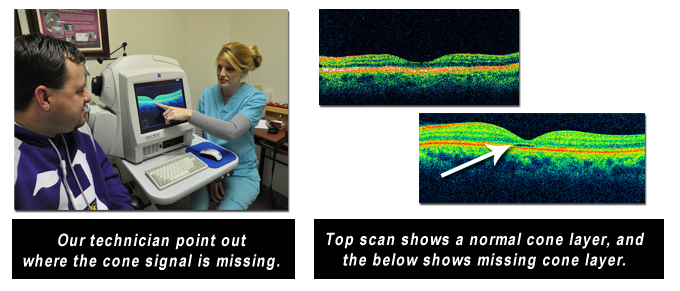
The cone cells have chemicals that work and are stable in bright light. Without cones cells, these patients must rely on the rod cells. Rod cells contain 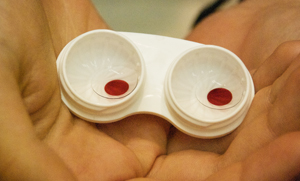 a chemical that is not stable in bright light, but works well in low light levels. These patients find their vision is washed out in bright lighting. Only by reducing light levels to a dark enough level that the rod chemicals are stable can the patient function well in daylight.
a chemical that is not stable in bright light, but works well in low light levels. These patients find their vision is washed out in bright lighting. Only by reducing light levels to a dark enough level that the rod chemicals are stable can the patient function well in daylight.
Various filters, dark sun lenses and hats have been used by these patients, but have not fully controlled the glare problems of these patients making it more difficult to take the next step of bioptic driving. However, recent 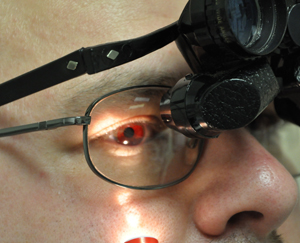 advancements in the fitting soft contact lenses and the useof red selective filters allows us to help most achromatopsia patients function better in bright lights inside and out.
advancements in the fitting soft contact lenses and the useof red selective filters allows us to help most achromatopsia patients function better in bright lights inside and out.
Our practice has worked extensively with these selective filtered contact lenses on patients from across the United States. These special red or dark amber filter contacts are custom prescribed in different levels of darkness in and different sizes of the filtered portion. They have revolutionized care for Achromatopsia patients and op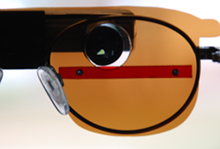 ened the possibility for more of these patients to be considered for bioptic driving
ened the possibility for more of these patients to be considered for bioptic driving
In Achromatopsia and Cone Dystrophies, even after we apply the red central contact lens, we can attach an additional small dense red filter to the base sunglass to enhance the patient’s ability to see the red stoplight.
The Low Vision Centers of Indiana
Richard L. Windsor O.D., F.A.A.O., D.P.N.A.P.
Craig Allen Ford O.D., F.A.A.O.
Laura Kathleen Windsor. O.D., F.A.A.O.
